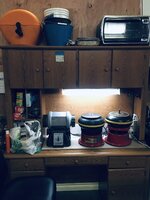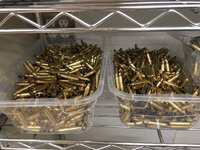Bronze Supporter
- Messages
- 880
- Reactions
- 302
I use wet to "clean" and media to "polish"
I have issues but here is my brass process
1. ultrasoinc
2. dry
3. decap and resize
4. wet clean with ss pins and laymen brass cleaner liquid additive
5. dry
6. tumble in corncob media with meguir's carnuba wax over night
7. separate media from brass
my limiting factor is my dryer, so for pistol I can do batches of 500, but for rifle on batches of 200
it takes some time, but the bulk of time is the tool doing the work, and I just have to move it from operation to operation every three hours, at the end of the day, I will start the tumbler and let it run over night then on step 7 in the morning.
and I agree, it does not shoot any more accurate, but it looks good in the case in my reloading room!
I have issues but here is my brass process
1. ultrasoinc
2. dry
3. decap and resize
4. wet clean with ss pins and laymen brass cleaner liquid additive
5. dry
6. tumble in corncob media with meguir's carnuba wax over night
7. separate media from brass
my limiting factor is my dryer, so for pistol I can do batches of 500, but for rifle on batches of 200
it takes some time, but the bulk of time is the tool doing the work, and I just have to move it from operation to operation every three hours, at the end of the day, I will start the tumbler and let it run over night then on step 7 in the morning.
and I agree, it does not shoot any more accurate, but it looks good in the case in my reloading room!














